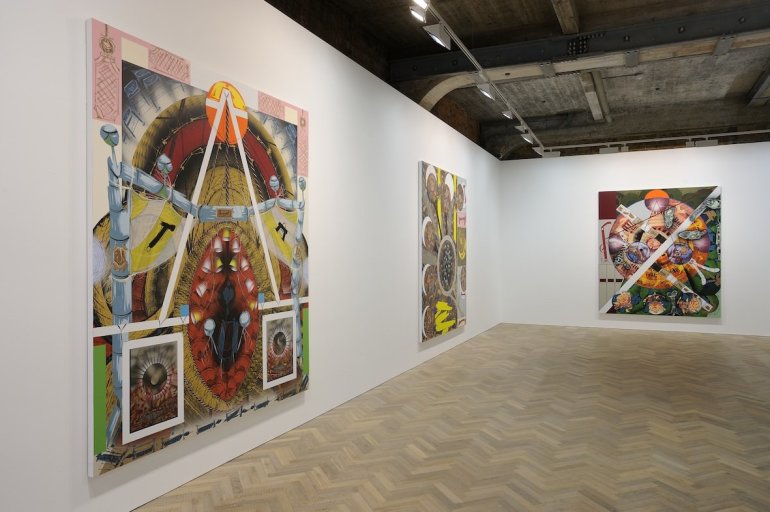Lari Pittman: THOUGHT-FORMS 8 Oct - 17 Nov 2012
'The painting is saying: "I am showing you what I look like, so now you show me yours' - L. Pittman
In an impossible attempt to summarize, or introduce Lari Pittman's paintings, the writer Klaus Kertess describes them as "splendid enigmas in the desert of mistrust for the imagination's power", revelling in a "staggeringly and stunningly detailed hyper-decorative Pop/folk agitation". (K. Kertess " The Meaning of Untitled", in 'Lari Pittman - Paintings and works on paper', 2005-2008, New York 2008, p.7)
Significantly Pittman (b. 1952) divides his time between Los Angeles and San Miguel de Allende in central Mexico. He consistently breaks the boundaries of accepted tastes, as if ignoring codes, edges and frontiers of cultures, such as the ones lying between his two countries of choice.
For a body of work that thrives so eruditely on art history (either mainstream, peripheral or folk), it seems to indeed resist all classification into genres and styles, and rather perversely displays symbolist riddles and sensual abandon - what Pittman himself calls "highly perfumed" works.
At the precise moment Pittman's paintings seem to be graspable and de-codable, they slip away again into fresh palette and structure and a new orgy of iconography.
Since his last exhibition in London, eight years ago, Pittman's cartoon-ish faces and eyes, the sardonic-strips, the kaleidoscopic and seemingly volcanic exuberance have made place for more and more esoteric palettes of beiges, purples, dark turquoises and greens, onto which the fluorescent outlines and networks of silhouettes and objects further break the background/foreground hierarchies.
In recent years, the paintings have become even richer, and if at all possible, even more daring, in the way they seem to be capable of representing the hypothetical (and jubilatory) clash of a Mexican Piñata and a Russian Teapot.
In 'thought-forms', human figures have almost entirely disappeared. In their place, birds, bells, belts, hanging ropes, shoes (and many more unrecognizable, mysterious motifs), fight and coexist in meticulous chaos. The deceptively rigorous system of lines, frames within frames, cameos and punch-holes slowly shifts and drifts into yet another unchartered territory.
Here we are presented with an exuberant series of concealing, elliptical, almost musical, variations of tempo, the reading of which requires both complete innocence and deep cultural references, and in which Symmetry, Logic - or more accurately, the subtle alteration (and subversion) of Symmetry and Logic, the simultaneous revelation of contradictory principles and generally a reflection on the cycle of life - seems to take central stage.
As often, Pittman's titles seem to hold the key not so much as an explanation of the work, but rather they function as a literal description of what is being presented visually: "thought-form of choreography, classification and spectral experiences", repeated in six smaller panels; or "thought-form of image patterns revealed at the time of death" and its parent piece, "thought-form of image patterns revealed at the time of birth" for example. Each of Pittman's 'thought-form' seem to be taking its cues from the ideas laid-out in its title, as if retroactively putting words into images, and as an open-ended invitation to re-imagine the way we look at painting.
Lari Pittman's work has been the subject of several exhibitions throughout Europe and the United States. Solo exhibitions include Villa Arson, Nice; ICA, London; Centre d'Art Contemporain, Geneva; Los Angeles County Museum of Art, Los Angeles; Contemporary Arts Museum, Houston; and Corcoran Museum, Washington DC. Pittman has been awarded the J. Paul Getty Trust Fund for the Visual Arts Fellowship Grant in Painting, NEA Fellowship Grants in Painting, and the Skowhegan Medal for Painting. A comprehensive monograph on Lari Pittman's work was published by Rizzoli in 2011.
For press enquiries and interviews with the artist please contact: Meredith@suttonpr.com
For general enquiries contact François Chantala: Francois@thomasdane.com


